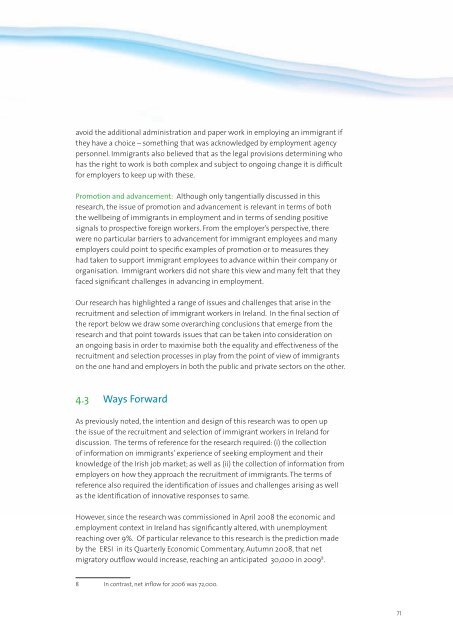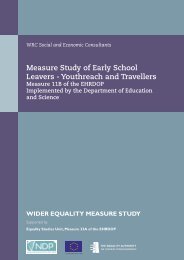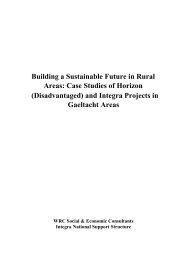Issues and Challenges in the Recruitment and Selection of ...
Issues and Challenges in the Recruitment and Selection of ...
Issues and Challenges in the Recruitment and Selection of ...
You also want an ePaper? Increase the reach of your titles
YUMPU automatically turns print PDFs into web optimized ePapers that Google loves.
avoid <strong>the</strong> additional adm<strong>in</strong>istration <strong>and</strong> paper work <strong>in</strong> employ<strong>in</strong>g an immigrant if<strong>the</strong>y have a choice – someth<strong>in</strong>g that was acknowledged by employment agencypersonnel. Immigrants also believed that as <strong>the</strong> legal provisions determ<strong>in</strong><strong>in</strong>g whohas <strong>the</strong> right to work is both complex <strong>and</strong> subject to ongo<strong>in</strong>g change it is difficultfor employers to keep up with <strong>the</strong>se.Promotion <strong>and</strong> advancement: Although only tangentially discussed <strong>in</strong> thisresearch, <strong>the</strong> issue <strong>of</strong> promotion <strong>and</strong> advancement is relevant <strong>in</strong> terms <strong>of</strong> both<strong>the</strong> wellbe<strong>in</strong>g <strong>of</strong> immigrants <strong>in</strong> employment <strong>and</strong> <strong>in</strong> terms <strong>of</strong> send<strong>in</strong>g positivesignals to prospective foreign workers. From <strong>the</strong> employer’s perspective, <strong>the</strong>rewere no particular barriers to advancement for immigrant employees <strong>and</strong> manyemployers could po<strong>in</strong>t to specific examples <strong>of</strong> promotion or to measures <strong>the</strong>yhad taken to support immigrant employees to advance with<strong>in</strong> <strong>the</strong>ir company ororganisation. Immigrant workers did not share this view <strong>and</strong> many felt that <strong>the</strong>yfaced significant challenges <strong>in</strong> advanc<strong>in</strong>g <strong>in</strong> employment.Our research has highlighted a range <strong>of</strong> issues <strong>and</strong> challenges that arise <strong>in</strong> <strong>the</strong>recruitment <strong>and</strong> selection <strong>of</strong> immigrant workers <strong>in</strong> Irel<strong>and</strong>. In <strong>the</strong> f<strong>in</strong>al section <strong>of</strong><strong>the</strong> report below we draw some overarch<strong>in</strong>g conclusions that emerge from <strong>the</strong>research <strong>and</strong> that po<strong>in</strong>t towards issues that can be taken <strong>in</strong>to consideration onan ongo<strong>in</strong>g basis <strong>in</strong> order to maximise both <strong>the</strong> equality <strong>and</strong> effectiveness <strong>of</strong> <strong>the</strong>recruitment <strong>and</strong> selection processes <strong>in</strong> play from <strong>the</strong> po<strong>in</strong>t <strong>of</strong> view <strong>of</strong> immigrantson <strong>the</strong> one h<strong>and</strong> <strong>and</strong> employers <strong>in</strong> both <strong>the</strong> public <strong>and</strong> private sectors on <strong>the</strong> o<strong>the</strong>r.4.3 Ways ForwardAs previously noted, <strong>the</strong> <strong>in</strong>tention <strong>and</strong> design <strong>of</strong> this research was to open up<strong>the</strong> issue <strong>of</strong> <strong>the</strong> recruitment <strong>and</strong> selection <strong>of</strong> immigrant workers <strong>in</strong> Irel<strong>and</strong> fordiscussion. The terms <strong>of</strong> reference for <strong>the</strong> research required: (i) <strong>the</strong> collection<strong>of</strong> <strong>in</strong>formation on immigrants’ experience <strong>of</strong> seek<strong>in</strong>g employment <strong>and</strong> <strong>the</strong>irknowledge <strong>of</strong> <strong>the</strong> Irish job market; as well as (ii) <strong>the</strong> collection <strong>of</strong> <strong>in</strong>formation fromemployers on how <strong>the</strong>y approach <strong>the</strong> recruitment <strong>of</strong> immigrants. The terms <strong>of</strong>reference also required <strong>the</strong> identification <strong>of</strong> issues <strong>and</strong> challenges aris<strong>in</strong>g as wellas <strong>the</strong> identification <strong>of</strong> <strong>in</strong>novative responses to same.However, s<strong>in</strong>ce <strong>the</strong> research was commissioned <strong>in</strong> April 2008 <strong>the</strong> economic <strong>and</strong>employment context <strong>in</strong> Irel<strong>and</strong> has significantly altered, with unemploymentreach<strong>in</strong>g over 9%. Of particular relevance to this research is <strong>the</strong> prediction madeby <strong>the</strong> ERSI <strong>in</strong> its Quarterly Economic Commentary, Autumn 2008, that netmigratory outflow would <strong>in</strong>crease, reach<strong>in</strong>g an anticipated 30,000 <strong>in</strong> 2009 8 .8 In contrast, net <strong>in</strong>flow for 2006 was 72,000.71




